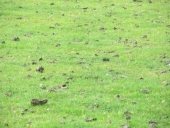I totally agree with Collin, and generally the answer to the original question is 'not really'. Though people don't really want to admit that, so you get answers like "but permaculture isn't about making money" or some such. Mostly defending permaculture, by saying that the OP is asking if anyone has made a square fit into a circle, with the obvious reply of 'of course not.'
There is a guy in Vermont who used to post here, who is farming for profit in a permaculture way
http://sugarmtnfarm.com/
I'll admit that it is hard for the average Joe, to feed themselves of a 1/4 acre section, let alone make money. You are going to need a decent amount of land, and a solid business plan, some experience with business and farming will help.
I agree with the OP re. Joel Salatin, I don't see that he is doing anything especially permaculture, importing tons of feed, no real systems supporting other systems etc. Just 'free range farming' which is not all that exciting or unique.
The concepts are good, design your land to save and conserve water, stack functions etc. but is the ROI of these modification positive? I think the payback period will be many, many years for things like swales and ponds. If you are going to put in a fence, or plant some trees, or starting something from scratch then you may as well use permaculture design systems, but I wouldn't be changing existing structures for the sake of permaculture and expect to get a positive ROI.
This topic has been thrashed before, and the stock standard answer is that the OP has no idea that permaculture isn't about money. Instead of a more honest answer of yes or no.






 )
)